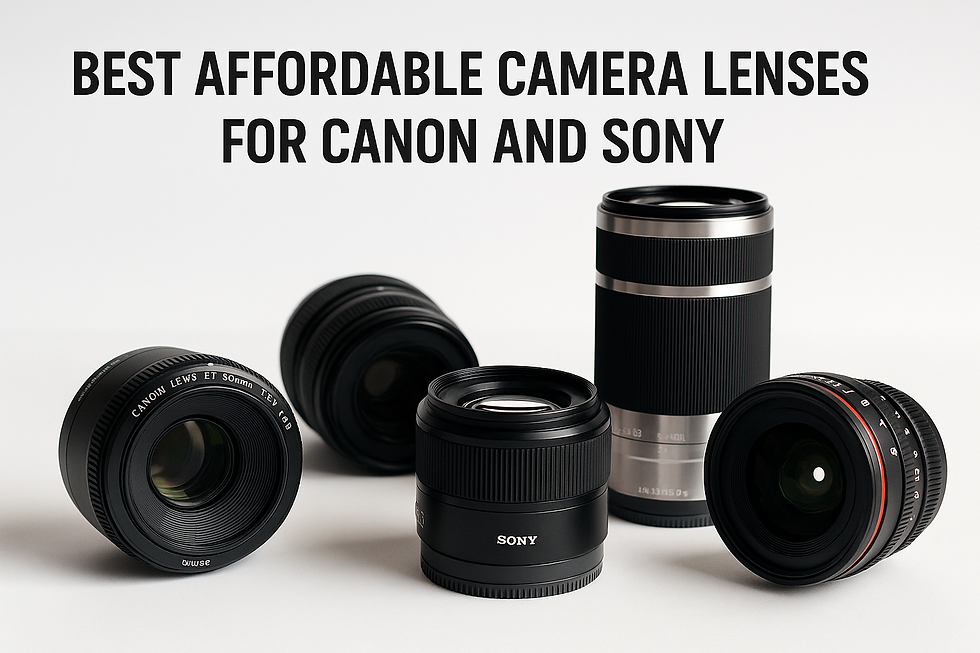Camera Lens Trends 2025 : What’s In and What’s Out
- Talha
- Jul 17
- 4 min read
The camera lens industry in 2025 is witnessing a major shift in both technology and user preferences. As content creation, photography, and cinematography become more democratized, manufacturers are rapidly adapting to meet the evolving demands of creators. Whether you're a professional filmmaker or a lifestyle vlogger, staying updated on the latest lens trends helps ensure you're using tools that enhance—not hinder—your creativity.
So, what’s dominating the scene in 2025—and what’s being left behind? Let’s dive into the biggest “ins” and “outs” of the year.
What's In: Top Camera Lens Trends of 2025
1. Lightweight Cine Lenses
The rise of solo creators and indie filmmakers has boosted demand for compact cinema lenses that don’t compromise on image quality. In 2025, lightweight cine lenses with full-frame coverage and T-stop consistency are favored for their portability and cinematic rendering.
These lenses are designed to balance perfectly with gimbals and handheld rigs, making them ideal for mobile production environments. They're quickly replacing traditional, heavy cine lenses in documentary, commercial, and YouTube filmmaking.
2. AI-Enhanced Autofocus
Lenses with built-in AI functionality are trending, especially among hybrid shooters who need reliable subject tracking for both photos and video. These lenses use machine learning to improve eye detection, predict motion, and maintain accurate focus in complex scenes.
Creators no longer need to worry about staying in focus while moving—an especially critical feature for vloggers, event shooters, and solo interview setups.
3. Wide-Angle Prime Lenses
Prime lenses with wide focal lengths (such as 16mm or 20mm) are in high demand for indoor vlogging, real estate content, and dynamic lifestyle shoots. They offer edge-to-edge sharpness with minimal distortion, even in tight spaces.
Moreover, their ability to render natural perspectives makes them a staple for everyday content creation. Compact and easy to carry, these lenses are replacing traditional zooms in many creator kits.
4. Fast Aperture Budget Lenses
2025 marks a golden age for affordable fast lenses. High-quality optics with wide apertures like f/1.4 or f/1.8 are now available at lower price points than ever before. Independent brands have stepped up their game, offering options that rival first-party lenses in sharpness, build, and autofocus capabilities.
A prime example is the growing interest in options like the sony 50mm 1.4 price in pakistan, which offers professional-level performance without exceeding mid-range budgets.
5. All-in-One Hybrid Lenses
Creators now expect a lens to do more than one job. Hybrid lenses, suitable for both still photography and video, are increasingly popular. These feature silent AF motors, de-clicked aperture rings, and minimal focus breathing—key for content creators who alternate between shooting styles.
A versatile hybrid lens can reduce gear load while still delivering exceptional results across use cases.
6. Sustainably Manufactured Lenses
Eco-conscious lens production is on the rise. Companies are using recyclable materials, energy-efficient glass processing, and sustainable packaging. This trend is especially popular among brands looking to meet environmental goals while appealing to ethically minded consumers.
What's Out: Camera Lens Trends Losing Relevance
1. Bulky DSLR-Only Lenses
As mirrorless cameras dominate the market, bulky DSLR lenses are rapidly becoming obsolete. Creators now favor mirrorless-native lenses that are smaller, faster, and more electronically integrated. Adapters are still used, but fewer professionals are investing in older DSLR glass.
2. Manual Focus-Only Lenses (Except Cine Use)
While manual focus lenses still have a place in cinema production, the average creator now expects fast, reliable autofocus. Manual-only lenses are declining in mainstream use, especially for run-and-gun videography and social content where speed is key.
3. Generic Zoom Kits
Basic 18–55mm kit lenses are no longer meeting the quality standards of modern creators. They're often being replaced immediately with sharp prime lenses or higher-end zooms that offer better bokeh, low-light performance, and image clarity.
4. One-Size-Fits-All Lenses
Generic superzooms that try to do everything (like 18–300mm) are falling out of favor. Though convenient, they often sacrifice optical performance. Creators are opting instead for specialized lenses tailored to their content type—portrait, landscape, macro, or video.
5. Noisy Autofocus Motors
Lenses with loud or jerky autofocus systems are being phased out. In the age of high-quality vlogging and livestreaming, viewers expect clean visuals and audio. Noisy focusing systems disrupt both, making these lenses unsuitable for modern content.
Regional Access to Modern Lenses
Thanks to increasing online availability and regional distributors, creators in countries like Pakistan have growing access to top-tier lens options. A wide selection of modern camera lenses is now available locally, offering a range of focal lengths, mounts, and price points tailored for today’s evolving creative demands.
Final Thoughts
In 2025, camera lenses are evolving in step with the content creation landscape. Lightweight builds, AI-driven features, and hybrid performance are becoming essential, while outdated bulk, noise, and generalization are being phased out.
By staying ahead of these trends, creators can build smarter, more versatile gear kits that support high-quality output and efficient workflows. Whether you're upgrading from a kit lens or building a professional setup from scratch, 2025 offers more flexible, intelligent, and user-focused lens options than ever before.


Comments